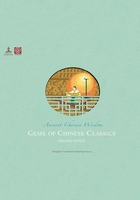
山海经 (shān hǎi jīng)
The Classic of Mountains and Seas
‘Strange book’ still keeping its secrets
Shan Hai Jing, also known as the “Classic of Mountains and Seas,” has been deemed a “strange book” since its first appearance in China in the 4th century BC.
On the basis of its title, most people would assume that it is a book about geography in ancient times, but its descriptions of the “mountains and seas” include encyclopedic entries — such as animals, plants, minerals, ancient history, medicine, folk customs, ethnic groups, myths, witchcraft and religions.
In addition, it gives running accounts of a number of strange stories. Since these stories are both very interesting and odd, even today people can’t decide whether they are fiction or true accounts of what really happened.
As a result, people still have different ideas about how to classify this text, whether to label it a book of geography, history or strange stories. Some even call it a mythological classic or a bestiary.
Adding to the mystery, we have no notion of who the author or authors were. Some historians believed that one of the authors of the book was Yu the Great, a legendary hero who devoted his life to creating flood control measures, tackling deluges that had plagued the country for centuries.
However, the book refers to events that happened after Yu’s time. Consequently, most later scholars agreed that this book was not written by a single author at one time.
Early versions of the book appeared in the 4th century BC and in the following centuries, quite a lot of scholars and historians must have made contributions to the book. Although it was first mentioned in Shiji or the “Historical Records” by Sima Qian (145-87 BC), the first known editors were Liu Xiang and Liu Xin, the famous father and son scholars of the Western Han Dynasty (206 BC-25 AD).
The book we see today is comprised of 18 chapters in around 31,000 Chinese characters. They include five chapters of the “Classic of Mountains,” eight chapters of the “Classic of Seas” and five chapters of the “Classic of Great Wilderness.”

The “Classic of Mountains” describes mainly the mountains, rivers, geological features, as well as animals, plants and mineral distributions in the order of south, west, north, east and central districts of the country.
The eight chapters of the “Classic of Seas” are divided into the “Regions Within the Seas” and the “Regions Beyond the Seas.” The former focuses on miraculous things and events in the country, while the latter describes the exotic customs and culture of other parts of the world.
The “Classic of Great Wilderness” contains many Chinese mythological stories about the Yellow Emperor, a legendary Chinese sovereign; Nuwa, the goddess who created human beings and mended the sky; the previously mentioned Yu the Great, the hero who tamed the rivers; and other legendary figures in the Chinese history. These stories have become an integral part of the Chinese mythology.
Some scholars believe that the “Classic of Mountains and Seas” was originally a book of illustrations, depicting geological features, strange animals and historical events. Then, the text was added to expand on the drawings. Over the time, all the illustrations were lost and the texts were passed down through generations to become a book of words.
Today, we can still find many different versions of the classic with rich illustrations, but none are original drawings. Because of its interesting, odd, rich and diverse contents, “Classic of Mountains and Seas” has been considered a bible for Chinese geologists, scholars, writers, historians, cultural and religious researchers and scientists for more than 2,000 years.
It has also been an important source of inspiration of many Chinese literary creations, artworks, as well as movies and TV plays.